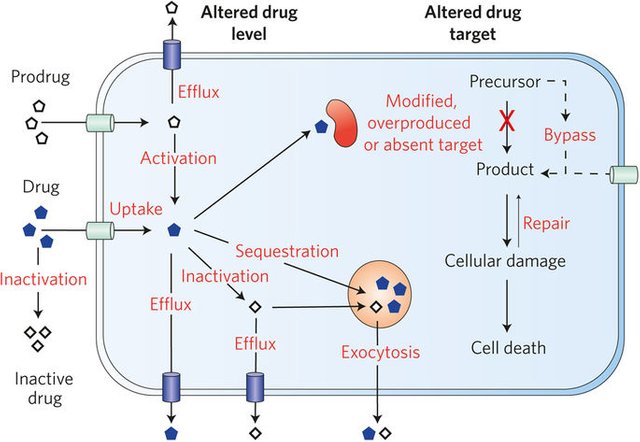Salads Under Siege, Episode 2: The Pathogen Running Game (1)
In this and my next post, I will revisit the idea of the plant-pathogen running game. This time, however, the focus will be on the pathogen side of the contest. In other words, I will describe the means by which pathogens try to keep up with the host. As it turns out, pathogens maintain large gene repertoires that allow them to either prevent changes in the host or respond to defense-associated events during infection.
Image: Collection of microbes that would love to infect plants, but probably can't!
In my previous post, we have established that plant-pathogen interactions represent a running game of life and death and that plants:
(i) Have evolved inducible defenses to fend off microbes that overcome physical barriers.
(ii) Defense-associated proteins are often secreted to combat infection and do so by
(iii) Either acting on the pathogen cell itself (lytic enzymes) or countering the activity of pathogen proteins that promote virulence.
Besides the synthesis and secretion of anti-microbial proteins, however, plant immune responses also feature the production of Reactive Oxygen Species (ROS) such as water peroxide (some people use this to bleach their hair...) and secondary metabolites. The mobilization of secondary metabolites signifies a distinct switch of plant cells into a defensive state (Piasecka et al., 2015). The host immune response, therefore, causes a drastic change to the host extracellular environment, turning previously healthy and nutritionally rich tissues into a hostile space, loaded with toxic substances. The fact that pathogens persist despite these changes tells us that these microbes have acquired mechanisms to cope with the first lines of host defenses. The question is: what are these mechanisms?
On the most basic level, pathogens can employ several cellular strategies to deal with active defense responses. All of these scenarios rely on the assumption that plant-derived toxins act on specific cellular targets that enable the toxic effect. For example, if toxin-A would act on an enzyme that mediates cell wall synthesis (which it needs for growth), a pathogen could circumvent this compound by evolving an improved version that is insensitive and continues to engage in cell wall construction despite the toxin.
Alternatively and if target modification is not possible without incurring a penalty (e.g., loss of enzyme activity), the pathogen could try to reduce toxin levels inside the cell. Mechanisms to achieve this include:
1. sequestration of toxic compounds using intracellular transport & storage inside organelles
2. Conversion of Toxin-A into its harmless sibling compound-B (for an example, see Wang & Wang, 2017)
3. Active export of the harmful chemicals out of the cell in an energy-dependent manner.

Figure 1. Strategies that allow microbes to cope with toxins (from Fairlamb et al., 2016). Source
Despite the vast interest in the biology of plant pathogens, we know little about the mechanisms I have described above, in the context of plant-microbe interactions. Given the advent of genome-wide studies of eukaryotic pathogens, we have failed to consistently identify or pinpoint gene repertoires with clear roles in detoxification (for example, see work on the saponins (Osbourn et al., 1996)). This observation contrasts success in the identification of factors that govern insensitivity to drugs or pesticides. I would thus suggest that either the contribution of detoxification needs to be properly and more intensely investigated or that pathogens have devised ways to prevent the accumulation of substances that are detrimental to fitness. While it is likely that both answers will carry some truth, I will focus on the suppression of inducible responses in my next post.
REFERENCES
Fairlamb, A. H., Gow, N. A., Matthews, K. R., & Waters, A. P. (2016). Drug resistance in eukaryotic microorganisms. Nature microbiology, 1, 16092.
Ishiga, Yasuhiro, et al. "The SAL-PAP Chloroplast Retrograde Pathway Contributes to Plant Immunity by Regulating Glucosinolate Pathway and Phytohormone Signaling." Molecular Plant-Microbe Interactions (2017): MPMI-03.
Osbourn, A. E., Bowyer, P., & Daniels, M. J. (1996). Saponin detoxification by plant pathogenic fungi. In Saponins used in traditional and modern medicine (pp. 547-555). Springer US.
Piasecka, A., Jedrzejczak‐Rey, N., & Bednarek, P. (2015). Secondary metabolites in plant innate immunity: conserved function of divergent chemicals. New Phytologist, 206(3), 948-964.
Wang, Y., & Wang, Y. (2017). Trick or treat: Microbial pathogens evolved apoplastic effectors modulating plant susceptibility to infection. Molecular Plant-Microbe Interactions, (ja).
For further reading on this topic, I would recommend the following posts:
https://steemit.com/food/@huitemae/salads-under-siege-the-plant-running-game-explained-episode-1
I hope you will find these pieces interesting. Your vote and follow help me open up the exciting world of plant biology and pathology to you.
Thank you @foundation for this fantastic SteemSTEM gif

Congratulations @huitemae! You have completed some achievement on Steemit and have been rewarded with new badge(s) :
Click on any badge to view your own Board of Honor on SteemitBoard.
For more information about SteemitBoard, click here
If you no longer want to receive notifications, reply to this comment with the word
STOPThis post was resteemed by @resteembot!
Good Luck!
Curious? Check out:
The @resteembot users are a small but growing community.
Check out the other resteemed posts in resteembot's feed.
Some of them are truly great.
This post has received a 16.50 % upvote from @buildawhale thanks to: @huitemae.
i found it @huitemae, :)